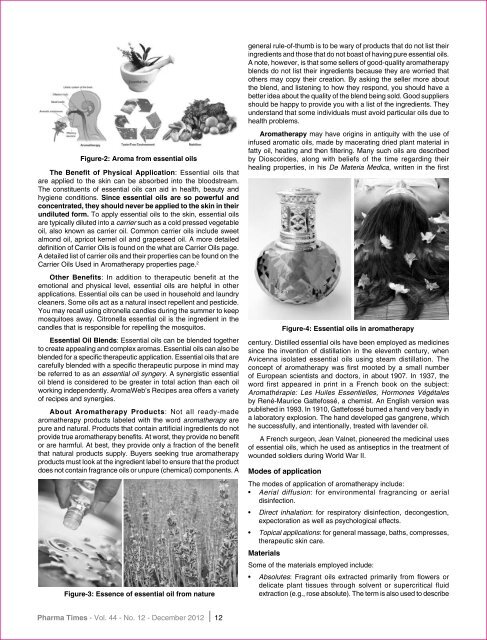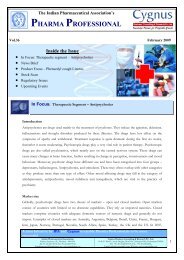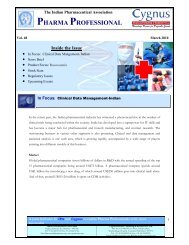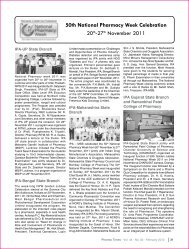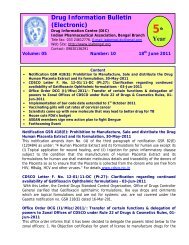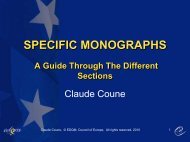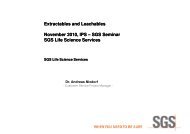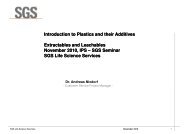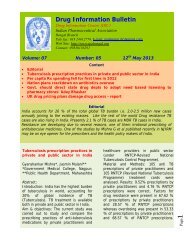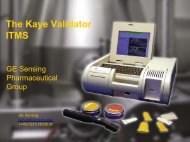Aromatherapy: The Doctor of Natural Harmony of Body & Mind
Aromatherapy: The Doctor of Natural Harmony of Body & Mind
Aromatherapy: The Doctor of Natural Harmony of Body & Mind
You also want an ePaper? Increase the reach of your titles
YUMPU automatically turns print PDFs into web optimized ePapers that Google loves.
general rule-<strong>of</strong>-thumb is to be wary <strong>of</strong> products that do not list their<br />
ingredients and those that do not boast <strong>of</strong> having pure essential oils.<br />
A note, however, is that some sellers <strong>of</strong> good-quality aromatherapy<br />
blends do not list their ingredients because they are worried that<br />
others may copy their creation. By asking the seller more about<br />
the blend, and listening to how they respond, you should have a<br />
better idea about the quality <strong>of</strong> the blend being sold. Good suppliers<br />
should be happy to provide you with a list <strong>of</strong> the ingredients. <strong>The</strong>y<br />
understand that some individuals must avoid particular oils due to<br />
health problems.<br />
Figure-2: Aroma from essential oils<br />
<strong>The</strong> Benefit <strong>of</strong> Physical Application: Essential oils that<br />
are applied to the skin can be absorbed into the bloodstream.<br />
<strong>The</strong> constituents <strong>of</strong> essential oils can aid in health, beauty and<br />
hygiene conditions. Since essential oils are so powerful and<br />
concentrated, they should never be applied to the skin in their<br />
undiluted form. To apply essential oils to the skin, essential oils<br />
are typically diluted into a carrier such as a cold pressed vegetable<br />
oil, also known as carrier oil. Common carrier oils include sweet<br />
almond oil, apricot kernel oil and grapeseed oil. A more detailed<br />
definition <strong>of</strong> Carrier Oils is found on the what are Carrier Oils page.<br />
A detailed list <strong>of</strong> carrier oils and their properties can be found on the<br />
Carrier Oils Used in <strong>Aromatherapy</strong> properties page. 2<br />
Other Benefits: In addition to therapeutic benefit at the<br />
emotional and physical level, essential oils are helpful in other<br />
applications. Essential oils can be used in household and laundry<br />
cleaners. Some oils act as a natural insect repellent and pesticide.<br />
You may recall using citronella candles during the summer to keep<br />
mosquitoes away. Citronella essential oil is the ingredient in the<br />
candles that is responsible for repelling the mosquitos.<br />
Essential Oil Blends: Essential oils can be blended together<br />
to create appealing and complex aromas. Essential oils can also be<br />
blended for a specific therapeutic application. Essential oils that are<br />
carefully blended with a specific therapeutic purpose in mind may<br />
be referred to as an essential oil syngery. A synergistic essential<br />
oil blend is considered to be greater in total action than each oil<br />
working independently. AromaWeb’s Recipes area <strong>of</strong>fers a variety<br />
<strong>of</strong> recipes and synergies.<br />
About <strong>Aromatherapy</strong> Products: Not all ready-made<br />
aromatherapy products labeled with the word aromatherapy are<br />
pure and natural. Products that contain artificial ingredients do not<br />
provide true aromatherapy benefits. At worst, they provide no benefit<br />
or are harmful. At best, they provide only a fraction <strong>of</strong> the benefit<br />
that natural products supply. Buyers seeking true aromatherapy<br />
products must look at the ingredient label to ensure that the product<br />
does not contain fragrance oils or unpure (chemical) components. A<br />
Figure-3: Essence <strong>of</strong> essential oil from nature<br />
<strong>Aromatherapy</strong> may have origins in antiquity with the use <strong>of</strong><br />
infused aromatic oils, made by macerating dried plant material in<br />
fatty oil, heating and then filtering. Many such oils are described<br />
by Dioscorides, along with beliefs <strong>of</strong> the time regarding their<br />
healing properties, in his De Materia Medica, written in the first<br />
Figure-4: Essential oils in aromatherapy<br />
century. Distilled essential oils have been employed as medicines<br />
since the invention <strong>of</strong> distillation in the eleventh century, when<br />
Avicenna isolated essential oils using steam distillation. <strong>The</strong><br />
concept <strong>of</strong> aromatherapy was first mooted by a small number<br />
<strong>of</strong> European scientists and doctors, in about 1907. In 1937, the<br />
word first appeared in print in a French book on the subject:<br />
Aromathérapie: Les Huiles Essentielles, Hormones Végétales<br />
by René-Maurice Gattefossé, a chemist. An English version was<br />
published in 1993. In 1910, Gattefossé burned a hand very badly in<br />
a laboratory explosion. <strong>The</strong> hand developed gas gangrene, which<br />
he successfully, and intentionally, treated with lavender oil.<br />
A French surgeon, Jean Valnet, pioneered the medicinal uses<br />
<strong>of</strong> essential oils, which he used as antiseptics in the treatment <strong>of</strong><br />
wounded soldiers during World War II.<br />
Modes <strong>of</strong> application<br />
<strong>The</strong> modes <strong>of</strong> application <strong>of</strong> aromatherapy include:<br />
• Aerial diffusion: for environmental fragrancing or aerial<br />
disinfection.<br />
• Direct inhalation: for respiratory disinfection, decongestion,<br />
expectoration as well as psychological effects.<br />
• Topical applications: for general massage, baths, compresses,<br />
therapeutic skin care.<br />
Materials<br />
Some <strong>of</strong> the materials employed include:<br />
• Absolutes: Fragrant oils extracted primarily from flowers or<br />
delicate plant tissues through solvent or supercritical fluid<br />
extraction (e.g., rose absolute). <strong>The</strong> term is also used to describe<br />
Pharma Times - Vol. 44 - No. 12 - December 2012 12


